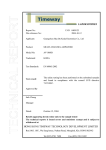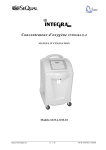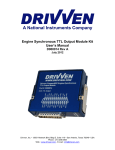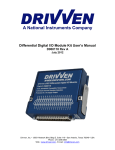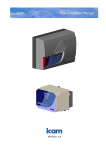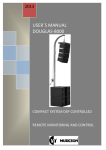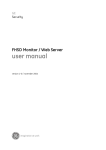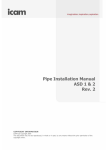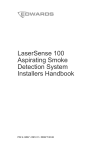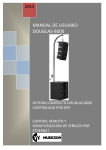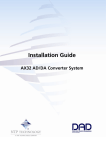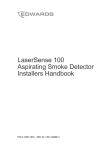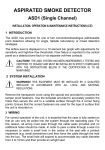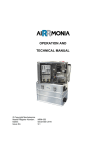Download VESDA ICAM IFT Product Guide
Transcript
Xtralis ICAM IFT Product Guide November 2008 Document Number: 14767_01 Part Number: 29237 Xtralis ICAM Xtralis ICAM IFT series Product Guide Intellectual Property and Copyright This document includes registered and unregistered trademarks. All trademarks displayed are the trademarks of their respective owners. Your use of this document does not constitute or create a licence or any other right to use the name and/or trademark and/or label. This document is subject to copyright owned by Xtralis AG (“Xtralis”). You agree not to copy, communicate to the public, adapt, distribute, transfer, sell, modify or publish any contents of this document without the express prior written consent of Xtralis. Disclaimer The contents of this document is provided on an “as is” basis. No representation or warranty (either express or implied) is made as to the completeness, accuracy or reliability of the contents of this document. The manufacturer reserves the right to change designs or specifications without obligation and without further notice. Except as otherwise provided, all warranties, express or implied, including without limitation any implied warranties of merchantability and fitness for a particular purpose are expressly excluded. General Warning This product must only be installed, configured and used strictly in accordance with the General Terms and Conditions, User Manual and product documents available from Xtralis. All proper health and safety precautions must be taken during the installation, commissioning and maintenance of the product. The system should not be connected to a power source until all the components have been installed. Proper safety precautions must be taken during tests and maintenance of the products when these are still connected to the power source. Failure to do so or tampering with the electronics inside the products can result in an electric shock causing injury or death and may cause equipment damage. Xtralis is not responsible and cannot be held accountable for any liability that may arise due to improper use of the equipment and/or failure to take proper precautions. Only persons trained through an Xtralis accredited training course can install, test and maintain the system. Liability You agree to install, configure and use the products strictly in accordance with the User Manual and product documents available from Xtralis. Xtralis is not liable to you or any other person for incidental, indirect, or consequential loss, expense or damages of any kind including without limitation, loss of business, loss of profits or loss of data arising out of your use of the products. Without limiting this general disclaimer the following specific warnings and disclaimers also apply: Fitness for Purpose You agree that you have been provided with a reasonable opportunity to appraise the products and have made your own independent assessment of the fitness or suitability of the products for your purpose. You acknowledge that you have not relied on any oral or written information, representation or advice given by or on behalf of Xtralis or its representatives. Total Liability To the fullest extent permitted by law that any limitation or exclusion cannot apply, the total liability of Xtralis in relation to the products is limited to: i. ii. in the case of services, the cost of having the services supplied again; or in the case of goods, the lowest cost of replacing the goods, acquiring equivalent goods or having the goods repaired. Indemnification You agree to fully indemnify and hold Xtralis harmless for any claim, cost, demand or damage (including legal costs on a full indemnity basis) incurred or which may be incurred arising from your use of the products. Miscellaneous If any provision outlined above is found to be invalid or unenforceable by a court of law, such invalidity or unenforceability will not affect the remainder which will continue in full force and effect. All rights not expressly granted are reserved. www.xtralis.com i Xtralis ICAM IFT series Product Guide Xtralis ICAM Document Conventions The following typographic conventions are used in this document: Convention Description Bold Used to denote: emphasis Used for names of menus, menu options, toolbar buttons Italics Used to denote: references to other parts of this document or other documents. Used for the result of an action. The following icons are used in this document: Convention Description Caution: This icon is used to indicate that there is a danger to equipment. The danger could be loss of data, physical damage, or permanent corruption of configuration details. Warning: This icon is used to indicate that there is a danger of electric shock. This may lead to death or permanent injury. Warning: This icon is used to indicate that there is a danger of inhaling dangerous substances. This may lead to death or permanent injury. Contact Us The Americas +1 781 740 2223 Asia +86 21 5240 0077 Australia and New Zealand +61 3 9936 7000 Europe, Middle East & Africa +41 1903 89 22 22 www.xtralis.com ii www.xtralis.com Xtralis ICAM Xtralis ICAM IFT series Product Guide Codes and Standards Information for Air Sampling Smoke Detection We strongly recommend that this document is read in conjunction with the appropriate local codes and standards for smoke detection and electrical connections. This document contains generic product information and some sections may not comply with all local codes and standards. In these cases, the local codes and standards must take precedence. The information below was correct at time of printing but may now be out of date, check with your local codes, standards and listings for the current restrictions. FDA This Xtralis ICAM product incorporates a 658 nm laser device with an average power less than 10 mW, and is classified as a Class 1 laser product that complies with FDA regulations 21 CFR 1040 with deviations pursuant to Laser Notice 50, and with IEC / EN 60825-1. Access to the laser chamber is on the underside of equipment and is restricted by cover. The cover may only be removed by qualified personnel. The laser emits visible light and can be hazardous if viewed with the naked eye. CAUTION - Use of controls or adjustments of performance or procedures other than those specified herein may result in hazardous radiation exposure. www.xtralis.com iii Xtralis ICAM IFT series Product Guide Xtralis ICAM Table of Contents 1 Introduction................................................................................................................................1 1.1 Detector Models.................................................................................................................1 2 Principle of Operation ...............................................................................................................2 2.1 Flow Monitoring .................................................................................................................2 2.2 Alarms and Trace Mode ....................................................................................................2 2.3 Detector Display Panel ......................................................................................................3 3 Installation..................................................................................................................................6 3.1 Mounting the Detectors......................................................................................................6 3.2 Cable Connections ............................................................................................................8 3.3 Connection of Sampling Tubes........................................................................................18 3.4 Remote Display Panel .....................................................................................................19 4 Starting Up ...............................................................................................................................20 4.1 Flow Normalization ..........................................................................................................20 5 Setup and Button Functionality .............................................................................................22 5.1 Access Codes ..................................................................................................................22 5.2 User Functions.................................................................................................................23 5.3 Main Menu Modes ...........................................................................................................24 5.4 Input-Output Modules ......................................................................................................35 6 Installation Guide for RS485 Equipment ...............................................................................40 6.1 Electrical Supply ..............................................................................................................40 6.2 Cable Material..................................................................................................................40 7 Maintenance .............................................................................................................................42 7.1 Servicing ..........................................................................................................................43 A Laser Chamber Safety.............................................................................................................44 iv www.xtralis.com Xtralis ICAM Xtralis ICAM IFT series Product Guide 1 Introduction Welcome to the Xtralis ICAM IFT series Product Guide. This document is written to provide you with information on technical specifications, cabling, and how to install, configure and operate the Xtralis ICAM IFT seriesdetectors. Xtralis ICAM IFT series detectors are aspirating smoke detectors that provide early warning of fire by analyzing air drawn through an air sampling pipe network. A highly sensitive detector chamber is able to detect smoke at very low concentrations. Embedded and PC software enable the configuration of a wide range of user defined parameters and reporting capabilities and extended input and output functionality is achieved through the addition of plug-in modules. 1.1 Detector Models Detectors in the Xtralis ICAM IFT range differ in a variety of ways including the number of sample tube inlets available, ability to provide individual pipe sampling, aspiration system and sample tube type. IFT-4 to IFT-15 detectors incorporate a rotary valve as a method of sampling individual pipes and providing addressability. This unique feature is described in Principle of Operation on page 2. The two types of aspiration systems used include an internal fan (low pressure system), or an internal vacuum pump (high pressure system). High pressure systems are capable of drawing air samples down small bore tubes while low pressure systems use wide-bore rigid sample tubes. Small bore systems are often preferred when installations need to be unobtrusive. Other features can be added as options to the basic system, including a high intensity warning beacon and TCP/IP MQ capability for connecting to Xtralis PC Software. Xtralis PC software has a monitoring capability that allows a large number of systems connected via TCP/IP MQ communications back to a single PC which can be accessed anywhere via any standard internet connection. The differentiating attributes for the detector models are summarized in the following table. Table 1-1: Detector Models and Differentiating Factors Model IFT-P IFT-1 IFT-4 IFT-6 IFT-8 IFT-15 Number of Sample Tubes 2 4 4 6 8 15 Individual Sampling (rotary valve) No No Yes Yes Yes Yes Individual Flow Monitoring No Yes Yes Yes Yes Yes Flow Monitoring System Thermal Sample tube inlet diameter 25mm OD Aspirator system Fan Pressure 21.4mm or ½”BSP 6mm OD / 4mm ID Pump 2000m 2000m 2000m N/A* N/A* Available with Beacon No Option Yes Yes Yes Yes Yes Available with Ethernet Option Yes Yes Yes Yes Yes Area Coverage 2 850m Yes 2 2 2 Note: * The IFT-8 and IFT-15 detectors are not designed for open-area coverage. However, for the purpose of calculating sampling point spacing, the equivalent maximum area coverage for the IFT-8 is 1500 m2 and the IFT-15 is 2000 m2. www.xtralis.com 1 Xtralis ICAM IFT series Product Guide Xtralis ICAM 2 Principle of Operation Air samples are drawn through the pipe network from the protected area through wide or small bore pipe systems. Wide bore tubes generally have sampling holes drilled at intervals within the protected area while small bore tubes normally sample air at their end points. The aspirator draws air from the pipe network into the detector inlets where the samples are combined, filtered, and directed to the laser detection chamber. Systems incorporating a rotary valve have an Overall position which draws air equally from all sectors. In contrast, the IFT-1 has an inlet manifold which combines samples from up to four inlet pipes while the IFT-P uses a T-piece of pipe to combine air sampled from two inlet pipes. All models, except the IFT-P, have flow monitoring on each inlet. The IFT-P has flow monitoring of the combined air-flow. More information on flow monitoring can be found in Section 2.1. The detection chamber consists of a laser beam directed across an optical chamber, through which the air sample flows. A photodetector built into the optical chamber measures the amount of light scattering from particles in the air. A clean air sample will cause very little scattering but as the smoke density of the sample increases, the amount of light directed onto the photodetector will also increase. The light signal is processed to become a direct measurement of the amount of obscuration caused by smoke. Information about the laser chamber can be found in Appendix A. If the smoke detected is higher than the preset alarm thresholds in the detector (Alert, Action, Fire 1 and Fire 2), an alarm will be reported. One or more Alarm relays, preset to activate at an alarm threshold will signal the host panel after a preset time delay. Alarm states are also shown on the display panel, and an audible warning is given. An optional alarm beacon can also be fitted. Systems with a rotary valve (IFT-4 to IFT-15) have an additional preset trigger level, Trace, usually set below the Alert level. When Trace is activated, the rotary valve will sequentially scan the sectors, in order to determine the source of the event. While in Trace mode, the default levels for Alert, Action, Fire 1 and Fire 2 are the same as used for Overall monitoring. If required, different levels for Alert, Action, Fire 1 and Fire 2 may be set for each sector in the Sector Alarms menu. The Overall alarm levels may also be changed as can all delay times (IFT-P and IFT-1 only). 2.1 Flow Monitoring The control system monitors for blockages or disconnection of tubes for each sector by detecting when the air-flow is above or below acceptable flow thresholds. Flow thresholds are dependant on air-flows measured during calibration. High pressure systems must have equal pipe lengths for all sectors before being calibrated. Low pressure systems calibrate flow readings to 100% for each sector; a calibration sequence to set this up must be performed at the installation stage. The unit has default high and low limits and associated delay times, but these may be changed in the Configure menu. 2.2 Alarms and Trace Mode The default settings of the four alarm states (Alert, Action, Fire1 and Fire2) and Trace (applicable to IFT4 and above) are shown in the following table. Table 2-1: Default Behavior of Alarm States and Trace Mode Threshold Latched / Unlatched Threshold Delay Beacon Pulse (On:Off) Sounder Trace Latched 0.03 % obs/m 3 secs - Continuous Alert Latched 0.04 % obs/m 3 secs 0.5 secs : 2 secs Continuous Action Latched 0.06 % obs/m 3 secs 0.5 secs : 1 sec Continuous Fire1 Latched 0.08 % obs/m 3 secs 0.5 secs : 0.5 secs Continuous Fire2 Latched 0.1 % obs/m 3 secs Continuous Continuous 2 www.xtralis.com Xtralis ICAM Xtralis ICAM IFT series Product Guide Trace parameters apply when the rotary valve is in the Overall position, and all sectors are being monitored. If latched, the Trace indicator will remain illuminated after the initiating event has ceased. It does NOT mean that the unit will continue indefinitely in Trace (scan) mode. The Alert relay may be functionally changed to act as a Trace relay instead. Its action will then follow that of the Trace indicator. If any alarms are unlatched, all resultant actions (relay contacts, panel indicators, sounder and beacon) will clear if and when the causative event ceases. If it is latched, all the warning mechanisms are maintained until action is taken by the user (please see Detector Display Panel on page 3). These alarm states are global and will be set depending on the smoke density being measured, regardless of which sector is being sampled. Once in Trace mode (IFT-4 and above), each sector has an alarm indicator associated with it. These individual sector alarms pulse progressively, depending on the degree of alarm status, in the same way as the Beacon (please see Table 2-1). If an aspirator fault (rotary valve fault for IFT-4, IFT-6, IFT-8 or IFT-15) coincides with an Alarm event, any alarm indicators that are ON will flash. 2.3 Detector Display Panel All IFT detectors, except for the IFT-P, can have a full display panel or a blank panel fitted to the main system. The IFT-P has no display but can be connected to a remote display unit via RS485 communications from the Main I/O module. The display panel is used for annunciating the detector status and smoke levels, and can also be used to configure the detector. The display consists of a range of configuration and control buttons (Item 1 in Figure 2-1) and LEDs to indicate Alarms, Faults, Power, Reset and other operational status (Items 5 and 6 in Figure 2-1). When configuring the detector via the display panel, some of these configuration and control buttons will have a dual function to allow the user to enter parameter values, scroll through configuration items, or enter an Access Code. Alternate functions are indicated by LEDs located above the buttons (Item 3 in Figure 2-1) and are activated when the associated button can be used for the alternative function. More information about button functionality, Access Codes and how to setup the detector with the Main Menu can be found in Setup and Button Functionality on page 22. 1. 2. 3. 4. Control and Configuration Buttons Status Display Alternate Button Function Indicators Sector, Alarm and Fault Indicators 5. Display LEDs 6. Alert, Action, Fire1 and Fire2 Indicators 7. Logarithmic smoke density bargraph Figure 2-1: IFT series Display Panel www.xtralis.com 3 Xtralis ICAM IFT series Product Guide Xtralis ICAM The following describe the display panel for the IFT detector. 1. Control and Configuration Buttons All local user-interface options are done using these buttons. 1. 2. 3. 4. Not used for IFT detectors Menu key Test key Scan / parameter scroll down key 5. Isolate / parameter scroll up key 6. Sounder silence / enter key 7. Reset / value scroll up key 8. Accept / value scroll up key Figure 2-2: Control and configuration keys Note: The display may be operated remotely. The unit can be accessed through ethernet (if fitted). 2. Status display Will normally show the smoke density value. Also used for all Setup and Configure procedures. 3. Alternate button function indicators When the unit is in a mode accessed by the Main Menu, the five right-most buttons can change to Scroll and Enter functions. 4. Sector, Alarm and Fault Indicators Individual Sample, Alarm, and Fault indicators for each sector. The All alarm is the Trace indicator. 5. Display LEDs 1. 2. 3. 4. 5. 6. 7. 8. 9. 10. 11. Power Processor reset Flow fault Aspiration fault Isolated Hold General fault Mains fault Battery fault Detector fault Communications fault 12. Unlock Figure 2-3: Function / fault LEDs 4 www.xtralis.com Xtralis ICAM Xtralis ICAM IFT series Product Guide Table 2-2: LED Descriptions LED Description Power Indicates that the power supply is ON General Fault The FireTracer has one or more faults, which will also be shown by other specific fault indicators. The Fault relay contacts always follow the state of this indicator. Isolated will also show as General Fault. General Fault will flash if the system processor is faulty Processor Reset The processor has been reset Mains Fault The primary AC supply has been absent for a programmable period of time. Please see the note below. Flow Fault The flow rate for any sector is outside the bounds set by the High and Low flow limits. On low pressure systems all sectors are normalized by a run-time sequence; on high pressure systems, the pipe lengths should be balanced. Battery Fault The battery is either disconnected, or has discharged to below 21.6 V. Systems without battery standby should have this function disabled in configuration by setting Standby to 0. Please see the note below. Aspiration Fault The rotary valve has a fault. Please see the note below. Detector Fault The laser smoke detector has developed a fault. Isolated This has been put into Isolated mode when the unit functions normally, but fault reporting via the relays is disabled. Note: General Fault will also be shown. Comms Fault An element of the internal RS485 communication link is faulty. Hold The FireTracer has been set to sample from only one sector. Unlock The Panel is unlocked - meaning that an access code has been entered. It will clear when normal operation is resumed. Note: If an Aspirator Fault coincides with an Alarm event, any Alarm indicators that are ON will flash. Note: When the Mains Fault appears, the system will work normally but the display starburst will be switched off in order to save battery power. It will return to Normal mode by pressing either the MENU or the TEST buttons. If the AC supply returns, the display will revert to normal mode. When the Battery Fault appears (i.e. if the battery supply fails or if the battery output voltage falls below 21.6 V), the system will enter an hibernation mode to avoid damaging the battery where everything (laser detector, fan, I/O modules etc.) except the Battery Fault indicator will be switched off. 6. Alert, Action, Fire1, and Fire2 Indicators These operate in tandem with corresponding relays on the I/O board to indicate progressive levels of smoke. They are programmable for both obscuration level and time delay. Please see the note below. 7. Logarithmic smoke density bar graph Displays 0 to 20 %obs/m with a resolution of 0.01 %obs/m at the lower end (0 - 6.09 %obs/ft). www.xtralis.com 5 Xtralis ICAM IFT series Product Guide Xtralis ICAM 3 Installation The units should be installed in accordance with the following installation instructions and in a manner acceptable to the local authority having jurisdiction (AHJ). The units are also intended to be installed in accordance with NFPA 72 National Fire Alarm Code. Warning: CAUTION - use of controls or adjustments of performance or procedures other than those specified herein may result in hazardous radiation exposure. The following steps should be carried out in order to correctly install the system: 1. Securely mount the back box to a suitable wall or support using the three points shown in the fixing diagrams in Section 3.1. M6 or M8 screws are suitable. 2. Connect the cables for the power supply, battery and any I/O modules. Ferrite cores should be fitted to the power cable, whether DC or AC. 3. Fit the pipe network to the system. For details on how to design and install a pipe network, see the Xtralis ICAM Pipe Installation Manual or refer to www.xtralis.com. 3.1 Mounting the Detectors Careful consideration should be given to the mounting location of the detector unit to ensure that it is: • Positioned at an accessible height to facilitate commissioning, routine testing and maintenance. • Positioned in an area where the exhaust air pipe will remain clear of obstacles at all times. • Not installed above a heat source such as a radiator or in direct air flow source such as Air Conditioners. • Secure and free from operation by unauthorized personnel. Pico Mounting Diagram and Dimensions 6 www.xtralis.com Xtralis ICAM Xtralis ICAM IFT series Product Guide IFT-1 Mounting Diagram and Dimensions IFT-4/6 Mounting Diagram and Dimensions IFT-8/15 Mounting Diagram and Dimensions www.xtralis.com 7 Xtralis ICAM IFT series Product Guide Xtralis ICAM 3.2 Cable Connections Note: All work carried out on these units should be performed by fully qualified personnel. There are no user serviceable parts inside. Before installing or removing batteries or carrying out any work that requires the removal of any board ensure that the power supply is disconnected. A fused junction box may be used as an external disconnect device. 3.2.1 External Power Supply Connection All units in the product range can be powered by an external 24 VDC power supply. Alternatively, all units, except for the IFT-P, can be installed with a 110 VAC or 230 VAC Mains PSU/ Battery Charger Optional Module (for more information, please refer to Section IFT-1, IFT-4, IFT-6, -8 and -15 Connections on page 9). The power supply cable cores should be fitted individually with ferrite cores, close to the cable gland inside the equipment case. To fit the cables with the ferrite cores, insert the 24V and 0V conductors through the ferrite cores and wrap around once to provide maximum effectiveness. Connect the 24 VDC power supply to the 5-way connector (CN2) on the I/O board under the control panel as shown in Figure 3-1 . Figure 3-1: 24 VDC connection for IFT Detectors The MAINS/BAT terminal must be linked to 0 V. Failure to do so may result in a Mains Fault. The VBAT and BATT TEST terminals should be left unconnected. Ensure that in the Configuration menu, the STANDBY parameter is set to 0. For more information about Configuration mode, please see Section CONFIGURE: Configuration Mode on page 25. To reset the any of the detectors in the IFT range of devices, apply 24 VDC to the Remote Reset input on the I/O board (i602). 8 www.xtralis.com Xtralis ICAM Xtralis ICAM IFT series Product Guide 3.2.2 IFT-1, IFT-4, IFT-6, IFT-8 and IFT-15 Connections This section describes the power, input and output connections for the IFT-1 to IFT-15 detectors and how to access the interfaces for the connections. The detector provides the interfaces as shown in Figure 3-2: • 24 VDC power input • Fault Relay contact connections • Auxiliary 24 VDC output supply - fused to 1 A for powering an external sounder, addressable I/O units etc. • Remote Reset input line - activated by applying 24 V • RS485 Communications - used for operating the display panel remotely • Ethernet connection - used for connecting to a host computer. The Unit can be monitored and driven remotely • RS232 connection - used for conducting Test/Configuration functions and interrogation of the Fault Log Data when connected to a Remote User Panel or a PC running Xtralis ICAM configuration software. The following interfaces are provided if an optional AC Mains / Battery Charger Module is installed in the detector (an alternative to a DC supply): • AC power input • Optional standby battery input connections • Temperature sensor (supplied) - this must be connected if back-up batteries are fitted www.xtralis.com 9 Xtralis ICAM IFT series Product Guide Xtralis ICAM Figure 3-2: IFT-1 to IFT-15 input and output interfaces 10 www.xtralis.com Xtralis ICAM Xtralis ICAM IFT series Product Guide Detector Access To gain access to the interior of the detector, first remove the front cover. It is secured by two screws underneath and hinged at the top, allowing complete removal. If the beacon option is fitted, a cableloom is attached; this may be unplugged at either end, but it may be easier to detach/reattach the plug connecting to the main unit. To access the Fault Relay and other I/O Module connections, the front panel must be dropped down by loosening the two knurled screw fixings at either side. As shown in the diagrams in Section Mounting the Detectors on page 6, knock-out cable entry points are provided at the top and left-hand side of the metal back box. Where the field wiring to the unit is not via conduit tubing, strain-relief type cable glands of a suitable size to fit the 25 mm diameter holes must be fitted to all used cable entry holes. These cable glands shall be fitted so as to provide strain relief and ensure that the protective earth connection (where used) is the last conductor to take any strain. Grounding and Fuse Protection An M5 chassis earthing stud is provided for the grounding of the unit, using a suitable gauge of wire or earth braiding (0.75 mm2 minimum), to a primary earth point (i.e. copper water pipe or an earth-stake etc.). This chassis earth should be connected on all DC powered installations, and must be utilized on AC installations by bolting the green/yellow flying lead from the power supply unit to it. The fuses used are: • Battery fuse - 5 mm x 20 mm glass cartridge 250 V, 8 A Quick Blow • Mains fuse - 5 mm x 20 mm HRC ceramic cartridge 250 V, 2 A Time Delay Optional Main Power Supply Connections As an alternative to using an external 24 VDC power supply, all units (except for the IFT-P) can be installed with a 110 VAC or 230 VAC Mains PSU/ Battery Charger Optional Module. When the AC mains power PSU/Battery charger is fitted, only the line and neutral conductors (not the protective ground conductor) should be fitted with ferrite cores, close to the cable gland inside the equipment case. Similar to external power supply cables, insert the line and neutral conductors through the ferrite cores and wrap them around once to provide maximum effectiveness. The mains power lead should be connected as per Figure 3-3. Note: All color coded installation wiring for the IFT smoke detector unit MUST BE done in accordance with requirements from the AHJ. Figure 3-3: Mains power connection www.xtralis.com 11 Xtralis ICAM IFT series Product Guide Xtralis ICAM Optional Standby Batteries All IFT detectors except the IFT-P can have optional standby batteries when they are fitted with the optional AC Mains PSU / Battery Charger Optional Module. Please note that battery should be able to support the detector on standby for at least 24 hours. Connect two 12 V sealed lead-acid (SLA) batteries (18 AH or less) in series. Position the batteries upright on the battery shelf, one in front of the other, with the terminals at the top. The recommended wire for the battery connection cable is 18 AWG (15 A) cable complying with UL 1007. The correct charging voltage is temperature dependent, and the temperature sensor (supplied) must be connected and taped to one of the batteries. If batteries are fitted, the internal charger must be enabled by configuring the STANDBY parameter to 1. Please refer to Section CONFIGURE: Configuration Mode on page 25 for information on Configuration Mode. The following batteries are recommended: • YUASA – Maintenance Free, Re-Chargeable Lead Acid Battery TYPE: NP 18.0-12 or Equivalent, or • YUASA – Maintenance Free, Re-Chargeable Lead Acid Battery TYPE: NP 17.0-12 or Equivalent. CAUTION! There is a risk of explosion if the battery is replaced with an incorrect type. Note: Please dispose of used batteries according to applicable requirements. 3.2.3 IFT-P Connections The IFT-P detector provides interfaces as shown in Figure 3-4. Tables in Input and Output Connections on page 13 provide detailed connection information for: • 24 VDC power supply. • Fault Relay contact connections. • Auxiliary 24 VDC output supply - fused to 1 A Fast and can be used for powering an external sounder, addressable I/O units etc. • Remote Reset input line - activated by applying 24 VDC. • RS485 Communications - used for operating the unit via a remote panel. • Ethernet connection - used for connecting to a host computer. The unit can be monitored and driven remotely via Xtralis VSC or VSM4 software. • RS232 connection - used for conducting Test/Configuration functions and interrogation of the Fault Log Data when connected to a PC running configuration software. Figure 3-4: Diagram of the I/O board for the IFT-P detector 12 www.xtralis.com Xtralis ICAM Xtralis ICAM IFT series Product Guide IFT-P units are powered by an external 24 VDC power supply. Access to the interior of the unit is gained by removal of the front cover. This is secured by four screw lock fixings (one at each of the four corners), releasing these fixings allows the removal of the cover complete with the ‘self-retained’ fixings. The Fault Relay and other I/O Module connections are all located on the (i602) printed circuit board immediately on the front face of the internal metal sub-chassis. The DC Supply fuse (FS1), TR5 style fuse 250V 2A Time Delay, is located on the (i602) printed circuit board. A cable entry gland is provided on the rear of the bottom casing for entry of the DC Supply Cabling and the field wiring cables. This cable gland is fitted so as to provide strain relief. The power supply cable cores should be fitted individually with ferrite cores, provided for the purpose, close to the cable gland inside the detector case. The 24 V and 0 V conductors are fed through the ferrite core and wrapped round once to provide maximum effectiveness. A second cable entry hole is provided, fitted with 0.2 to 2 mm grommet, to facilitate the Ethernet cable (if used). 3.2.4 Input and Output Connections The following tables define input and output connections for the IFT series. www.xtralis.com 13 Xtralis ICAM IFT series Product Guide Xtralis ICAM Table 3-1: Connections for i602 I/O Board CN1: RS232 Communications 2 Receive Data 3 Transmit Data 5 0V 1, 4, 6, 7, 8, 9 N/C Shell Earth (Screen) Requires suitable twisted screened cable up to a maximum distance of 15 m. CN2: DC Supply 1 0 VDC in 2 N/C 3 N/C 4 Mains/Battery 5 0 VDC in Connection requirements: • • 16 x 0.25 - 15 A (18 AWG) cable (0.75mm2 minimum IEC60227 H05 W-F/H05 WH2-F2 for EC), or Direct connection from AC PSU Option Module ‘flying lead’ if fitted) Note: For 24 VDC operation, add a wire link between Pin 2 (0 V) and Pin 5. Note: See Section External Power Supply Connection on page 8 for further details Note: For Mains/Battery connection, please see notes below. CN3: Auxiliary Supply Output 1 0 VDC 2 24 VDC Requires 7 x 0.2 - 6 A (24 AWG) cable (1 A maximum load) CN4: Remote Reset Connections 1 - input 2 + input Opto isolated input. 24 VDC low current signal. CN6: RS485 Communications 1 Shield Belden 9842 cable (or suitable equivalent) 2 RS485 - 3 RS485+ Note: Ensure that the Mid/End Jumper Link is fitted correctly on pins 7/8/9 of CN 5. Please see Section Installation Guide for RS485 Equipment on page 40 for further details CN7: Output Relay Connections 1 C Requires 7 x 0.2 - 6 A (24 AWG) cable 2 NC Note: Maximum relay contact rating is 2 A @ 30 VDC. 3 NO Note: Please see Section 4-Channel Relay Module on page 35 for further details. 4 FIRE 2 FIRE 1 C 5 NC 6 NO 7 ACTION C 8 NC 9 NO 10 ALERT C 11 NC 12 NO 13 FAULT C 14 NC 15 NO Note: Connection CN14 is only used for special applications. 14 www.xtralis.com Xtralis ICAM Xtralis ICAM IFT series Product Guide Table 3-2: Connections to RABBIT Processor Board Connector Pin Description Description 8-pin RJ45 Standard Ethernet connections Standard Ethernet cable. Note: See Section Installation Guide for RS485 Equipment on page 40 for further details. Table 3-3: Connections From 4 Channel Relay Board (Optional Module) Output Relay Connections (i606) 1 C Requires 7 x 0.2 - 6 A (24 AWG) cable 2 NC Note: Maximum relay contact rating is 2 A @ 30 VDC. 3 NO Note: Please see Section 4-Channel Relay Module on page 35 for full operational details . 4 Relay 1 Relay 2 C 5 NC 6 NO 7 Relay 3 C 8 NC 9 NO 10 Relay 4 C 11 NC 12 NO Table 3-4: Connections To/From Suppression Board (Optional Module) Input/Output Connections (i623) 1 Relay 1: Solenoid 1 2 3 Relay 2: Solenoid 2 4 5 Relay 3: Alarm 1 Relay 4: Alarm 2 Pressure Switch 1 Pressure Switch 2 Note: See Section 2-Channel Extinguisher Module on page 38 for full operational details + + + - Manual Call Point 1 14 15 Pressure Switch and Call Point inputs - requires 7 x 0.2 - 6 A (24 AWG) cable - 12 13 Relay RL1 to RL4 outputs - fused at 2 A, requires 7 x 0.2 - 6 A (24 AWG) cable. - 10 11 + - 8 9 + - 6 7 + + - Manual Call Point 2 16 www.xtralis.com + - 15 Xtralis ICAM IFT series Product Guide Xtralis ICAM Table 3-5: Connections From Current Output Board (Optional Module) Output Connections (i624) 1 Output 1 2 3 Output 2 4 5 Output 3 Output 4 Output 5 Output 6 16 16 Note: See Section 8-Channel, 4 - 20mA Output Module on page 36 for full operational details + + + - Output 7 14 15 • 20 VDC max. • 4 - 20 mA output current (optional 0 - 20 mA) • 7 x 0.2 - 6 A (24 AWG) cable - 12 13 All outputs have the following specifications: - 10 11 + - 8 9 + - 6 7 + + - Output 8 + - www.xtralis.com Xtralis ICAM Xtralis ICAM IFT series Product Guide The following tables do not apply to the Xtralis ICAM IFT-P detector. Table 3-6: Connections To Remote Panel (Optional) - from I620 Control Board RS485 Remote Control Data 1 +24 VDC: Supply out Belden 9842 (24 AWG) cable (or equivalent) 2 0 V: Supply Common 3 RS485 + 4 RS485 - Note: Ensure that the Mid/End Jumper Link is fitted to the End position (pins 1 and 2 of CN 6). Note: Please see Sections Remote Display Panel on page 19 and Installation Guide for RS485 Equipment on page 40 for further details Note: Please refer to Section Remote Display Panel on page 19 for details. Table 3-7: Connections for 110 VAC and 230 VAC Mains PSU/Battery Charge (Optional Module) A/C Supply Connector 1 Live 2 Neutral 3 Earth Requires 16 x 0.25 - 15 A (18 AWG) cable (0.75mm2 minimum IEC60227 H05 W-F/H05 WH2-F2 for EC) Back-Up Battery Connector 1 0V (to Negative battery terminal) Requires 26 x 0.25 - 19 A (16 AWG) Cable (1.5mm2 minimum) 2 24 V (to Positive battery terminal) Note: See Section IFT-1, IFT-4, IFT-6, -8 and -15 Connections on page 9 for further details Battery Thermistor Connection 1 Battery Thermistor Battery Thermistor connections are not polarity sensitive. 2 Battery Thermistor Note: The Battery Thermistor must be connected when a Back-up Battery is connected Mains PSU DC Output Connection 5 pin Flying Lead Connector www.xtralis.com Connects to CN 2 on i602 Board 17 Xtralis ICAM IFT series Product Guide Xtralis ICAM 3.3 Connection of Sampling Tubes Note: For more details please refer to the Pipe Installation Manual. There are several common guidelines that should be followed when attaching the pipe network to the IFT detector: • Pipes must NEVER be glued to the inlets of the detector • Pipe network itself MUST be glued together • Use removable unions where necessary Unused inputs on the IFT-8 and IFT-15 detectors should be looped to one another using short lengths of microbore. For example, if an IFT-15 has unused inputs 9 to 15, one way of connecting the unused inputs would be to use short pieces of microbore to connect inputs 9 to 12, 10 to 13, 11 to 14 and have input 15 capped off. Ensure that these short lengths of microbore do not kink. Do not insert ANY object into the inlet ports other than the correct size of piping. This is to avoid damage to delicate electronic flow sensor components mounted just inside each port opening. Other pipe and inlet specifications are addressed in the following table. Table 3-8: Detector Inlet to Pipe Network Termination Specifications Detector Inlet Port IFT-P Maximum Pipe Length Other Considerations 25 mm outer- 25 mm; or diameter 26.7 mm (0.75 in.) with UPVC tubes 25 to 26.7 mm (0.75 in.) adaptors 100 m - IFT-1 Tapered push- 26.7 mm (0.75 in.) to 25 fit mm 100 m - IFT-4 and IFT-6 Tapered push- 25 mm; or 100 m fit 26.7 mm (0.75 in.) with 25 mm to 26.7 mm (0.75 in.) adaptors - IFT-8 and IFT-15 18 Acceptable Pipe or Adapter 6 mm outer-diameter, 4 mm inner-diameter flexible nylon tube 50 m Note: Pipe lengths should be equal Other materials may be used e.g. FEP/ Stainless Steel with suitable adaptors for harsh environments www.xtralis.com Xtralis ICAM Xtralis ICAM IFT series Product Guide 3.4 Remote Display Panel An installation kit is available for mounting a display panel up to 1 km away from the detector. It contains: • 1 Blanking plate • 1 Mounting Box • 1 Fixing kit Figure 3-5: Display board and terminal for remotely connecting the Display Panel Suitable double twisted pair cable for connecting RS485 communications and 24 VDC power can also be supplied. More information may be found in Section Installation Guide for RS485 Equipment on page 40. When using the double twisted pair cable, use one pair for RS485 communications, the other pair for 24 VDC supply, and ensure that matching signals are connected at each end. To use the Display Panel remotely, the main unit must also be configured for remote display operation by following these steps (please see Figure 5-1 for User Function buttons): 1. 2. 3. 4. 5. 6. 7. 8. Press MENU Use Parameter UP & DOWN to reach SETUP (Scan and Isolate buttons) Press ENTER Enter Access Code 931 - please refer to Access Codes on page 22 for how to enter the Access Code Use Parameter UP & DOWN to reach REMPANEL If the display shows REMPANEL 0 then press Value UP to get REMPANEL 1 Press ENTER Press MENU twice to revert to normal www.xtralis.com 19 Xtralis ICAM IFT series Product Guide Xtralis ICAM 4 Starting Up After installation, it will be necessary to power up the system for configuring the detector according to site requirements and also to ensure that the detector and associated pipe network is properly installed. When powered-up, the display will first show a rolling text message showing: • • • • • IFT detector type: FIRETRACER FT [1, 4, 6, 8, 15] Software version: VERSION *.** Optional text 1 Optional text 2 Optional text 3 Optional text information are user definable options differing from the factory default settings (please see 1 and 2 below) or a factory build option (please see 3 below): 1. REM PANEL - the unit may be configured to operate the display panel remotely using the RS485 communications. 2. NO DET FLOW - the flow measurement through the detector chamber itself may be disabled 3. MQ Support - this is a factory software build option. If built with TCP/IP support, MQ message is displayed 4.1 Flow Normalization After the initial power-up of the system, flow normalization is necessary for the detector to learn the airflow characteristics of the system. To perform normalization on a detector, please follow these steps: 1. 2. 3. 4. Press MENU (on earlier models it is labeled CODE) Use Parameter UP & DOWN (Scan or Isolate buttons) to scroll to CONFIGURE Press ENTER (Sounder silence button) Enter Access Code 260 - please see Section Access Codes on page 22 for more information on Access Codes. 5. Use Parameter UP & DOWN to reach SETFAN (for high pressure units scroll to TESTTIM). 6. Press ENTER. The display should show SETFAN 5 (the digit 5 should flash) 7. Press ENTER. A rolling text message shows progress. When complete, the display resumes at OBSC/M 0.00% Figure 4-1: Buttons for normalization 20 www.xtralis.com Xtralis ICAM Xtralis ICAM IFT series Product Guide 4.1.1 Wide Bore systems (IFT-P, IFT-1, IFT-4, IFT-6) Air-flow is directly affected by the fan speed in wide bore systems. The fan speed is programmable from 3 to 10 (please see Configuration Mode Section CONFIGURE: Configuration Mode on page 25) and the factory default setting is 5. It is recommended that it be left at 5 unless otherwise advised (e.g. long pipe lengths). Once the pipe work has been completed it is necessary for the unit to learn the values of flow rates at each inlet. Once done, all displayed flow rates will be normalized to 100%. The process will take about six minutes, and a rolling text message indicates progress. Note: If the unit is in alarm a flow calibration cannot be performed. Note: Press MENU to abort normalization at any stage. Note: For high pressure systems after TESTTIM is selected a rolling text message will show progress. Note: When complete, the display resumes at OBSC/M 0.00% 4.1.2 Small bore systems (IFT-8, IFT-15) Small bore systems rely on the pump speed to provide the vacuum rates in the system. The pump speed cannot be altered from the factory default value under any circumstances. Once the pipe work installation has been completed and terminated to the system it is necessary for the unit to learn the values of vacuum rates at each inlet. This is accessed by pressing enter at the TESTTIM function within Configuration mode. Once done, all displayed flow rates will be set to 100%. The process will take around 6 minutes, and a rolling text message indicates progress. On completion of the flow calibration process, document the values identified in the procedure below. 1. Enter the Maintenance list to display REL in. 2. Record REL in with system monitoring in overall position. Reset the unit to initiate a scan. 3. Record REL in values for each sector. Figure 4-1 shows the button functions for a flow calibration procedure. www.xtralis.com 21 Xtralis ICAM IFT series Product Guide Xtralis ICAM 5 Setup and Button Functionality The configuration of the detector is achieved by using a PC loaded with Xtralis ICAM configuration software or through the display panel. This section provides information on the button functionality in the display panel, and how to setup the detector and navigate through the Main Menu options. Figure 5-1: IFT detector buttons for user functions 5.1 Access Codes Access to some modes in the Main Menu and other configuration and control functions require the user to enter an Access Code. There are several levels of access: 1. 2. 3. 4. Operator Level 1 Level 2 Level 3 Access Code Levels are downwards applicable - for example if a User enters the Level 2 Code, they have access at the Operator Level and Level 1. The Operator Access Code is changeable as a parameter in Configuration Mode, which requires Level 1 Access. The default Access Codes are shown below. Table 5-1: IFT Detector Access Codes Access Level Access Code Operator 0 Level 1 260 Level 2 693 Level 3 Factory Use Only 5.1.1 How to Enter an Access Code When entering an Access Code, the alternative function LEDs above the ACCEPT and RESET buttons will be lit, enabling these buttons to be used as UP and DOWN buttons to enter a 3-digit number. If the UP or DOWN buttons are continually pressed, the 'units' digit on the Status Display will be activated, then the 'tens' digit, then the 'hundreds' digit. If the button is released, the flashing digit (units, tens or hundreds) is the one that will change with further use of the UP and DOWN buttons. When the hundreds digit is correct, wait about five seconds for the flashing digit to move to the tens digit, then set the tens to the required value. Repeat for the units digit. 22 www.xtralis.com Xtralis ICAM Xtralis ICAM IFT series Product Guide 5.2 User Functions User functions associated with some configuration and control buttons are described in this section. For more information on setup and configuration, please refer to Setup and Button Functionality on page 22. Table 5-2: Description of User Functions for the Display Panel Function Access Level Description ACCEPT None Acts only on the internal sounder. Acknowledges all current Alarm states. All other warning mechanisms continue unchanged. Sounder operation changes from continuous to 1 second ON: 15 seconds OFF. New Alarm events cause the sounder to revert to continuous operation. SOUNDER Operator SILENCE Acts only on the internal sounder. The Sounder is switched off until one or more new Alarm events. RESET Operator Clears down all latched Alarms and Faults. Current Alarms or Faults will remain. ISOLATE Operator Used when diagnosing faults, testing new installations etc. All fault relays are disabled, so that Alarm and/or Fault conditions will not be reported back to the Host Panel. The Isolate button toggles the unit between Isolated and Normal operation, as shown by the Isolated indicator, but see note below. TEST None Successive presses of the Test button show: 1. Date on the Status Display 2. Time on the Status Display 3. IP address (if the unit is TCP/IP (MQ) enabled) on the Status Display 4. Subnet net mask (if the unit is TCP/IP (MQ) based) on the Status Display 5. Media Access Control (MAC) address (if the unit is TCP/IP (MQ) enabled) on the Status Display 6. All activated LEDs on the panel and LED segments on the Status Display 7. Normal display The IFT detector can also be reset remotely by applying 24 VDC to the remote reset input on the Main I/O PCB (please refer to Section 3.2.2). Note: If the unit is isolated then returned to the Normal, Locked state (by pressing the MENU button) the Operator will need to re-enter Operator Access Code in order to cancel the Isolated state. Note: When the Operator Access Code is entered (default = 0), the Sounder Silence, Reset and Isolate user functions are enabled and the unit is placed in the Unlock state, as shown by the flashing Unlock indicator. To reduce the possibility of leaving the unit in this condition, the system will indicate a fault condition on the display and to the remote monitoring device via the fault relay. If the unit is isolated, then returned to the Normal, Locked state (by pressing the Main Menu button) the Operator will need to re-enter Operator Code in order to cancel the Isolated state. If any button is not pressed to lock the panel the unit will self-timeout and lock in 3 minutes. Note: If the unit is set for battery backup and the mains supply fails (or is removed) the displays will switch off in order to conserve battery power. www.xtralis.com 23 Xtralis ICAM IFT series Product Guide Xtralis ICAM 5.3 Main Menu Modes To enter one of the Main Menu Modes follow these steps: 1. Press MENU 2. Use Function UP & DOWN buttons (SCAN and ISOLATE buttons) to reach required main menu item 3. Press ENTER (SOUNDER SILENCE button) 4. Use Value UP & DOWN buttons (RESET and ACCEPT buttons) to enter the appropriate Access Code 5. Press ENTER Note: Access Code Entry may be aborted by pressing the MENU button. Note: All of the following settings can be entered using the Xtralis ICAM configuration software and a PC. This can reduce the time taken to enter certain values and parameters. To obtain this software contact Xtralis or visit the website www.xtralis.com. The following sections show how to enter the Main Menu Modes and what parameters are available in each of these modes. 5.3.1 FAULTS: Fault List Minimum Access Level Required: None This menu item shows a list of the faults that are current in the system. Use the Function UP & DOWN buttons (Isolate and Scan) to inspect any current fault in the list. 5.3.2 OPERATOR: Operator Mode Minimum Access Level Required: Operator This menu item enables the user to specifically enter Operator Mode, and permits the usage of the Isolate, Sounder Silence and Reset buttons. Once the user has successfully entered the Operator Access Code, the Unlock LED should activate. 24 www.xtralis.com Xtralis ICAM Xtralis ICAM IFT series Product Guide 5.3.3 ENGINEERING: Engineering Mode Minimum Access Code Required: None Certain engineering values may be inspected, primarily for diagnostic purposes. Use the UP & DOWN buttons (Isolate and Scan) to inspect any parameter in the list. Table 5-3: Engineering Parameters and Values Parameter Value Description VERSION 2.47 Version of Software in the processor module in the Main Unit. The software can be upgraded using a PC and a special interconnect lead. BUILD NO *.** Reference to specific software build. GENERAL FAULT *.** Fault list that generates fault number codes. DETFLOW **.*% Sample flow through the detector. This measurement may be enabled/disabled under Configuration. FLOWnn **.*% Measurements of Sample flow rates for each sector. The number will vary depending on the Model Type and number of actual sectors sampled. For low pressure (wide bore) systems, the flow rates should be normalized to 100% at installation. High pressure systems measure pressure for each sampled sector. The tube lengths should be equal. BATTERY **.* V Measurement of the battery voltage. Note that this applies only if the optional battery is fitted. The Standby option must also be enabled under Configuration. OBS/M or OBSC/FT *.**% Obscuration value in meters or feet. This is the same as the normal display. To change from metric to imperial see section 3.4.6. REFDENS *.**% Reference Density. MODn 1 to 5 Shows the module types that are fitted. These are read directly from the Modules. 5.3.4 CONFIGURE: Configuration Mode Minimum Access Code Required: Level 1 The IFT detector uses many configuration parameters, and is shipped with factory default values. The Configuration Mode allows changes to be made to these parameters. Below is a list of user definable parameters, and their Factory Default values. The Parameter UP and DOWN buttons (Isolate and Scan) navigate through the list; the Value UP and DOWN buttons (Accept and Reset) change the value. The ENTER button (Sounder Silence) saves the new value, and moves to the next parameter. www.xtralis.com 25 Xtralis ICAM IFT series Product Guide Xtralis ICAM Table 5-4: Configuration Mode Parameters and Values Parameter Range Factory Default OPCODE Operator Function Access Code 0 to 999 0 ENDSCTR End Sector (number of sectors used) 1 - default 4, 6, 8 or 15 DENSLOG Log of density change 0.01 to 20.00 0.02 F2LTCH Fire 2 Latch 0 or 1 1 F1LTCH Fire 1 Latch 0 or 1 1 ACTLTCH Action Latch 0 or 1 1 ALTLTCH Alert Latch 0 or 1 1 TRCLTCH Trace Latch 0 or 1 1 FLTLTCH Fault Latch 0 or 1 1 TRCRLY Trace Relay 1 0 or 1 0 REFCOMP Reference Compensation 0 to 5% 2.00% REFDEL Reference Delay 5 to 60s 15s FLOWDEL Flow Fault Delay 1 to 60s 5s FLOWHI Flow High Limit 0 to 200% 120% FLOWLO Flow Low Limit 0 to 200% 80% FLOWLOG Log of flow change 0.0 to 200.0 5.0 SETFAN Set Fan Speed 3 to 10 5 STANDBY Battery Charger Enable 0 or 1 0 PWRDEL AC power supply fail delay 1 to 1000s 10s BUZZER Internal Sounder Enable 0 or 1 1 BEACON Beacon Enable 0 or 1 1 ADDRESS RS485 Address 0 to 30 31 (off) TESTTIM Time between automatic scans Note: TESTIM is also used for IFT-15 Flow calibration by pressing ENTER 1 to 30 mins 20 MINDWELL Rotary valve dwell time 1 to 100 1 GAINX See description MOD1 Set Module 1 usage MOD2 Set Module 2 usage MOD3 Set Module 3 usage MOD4 Set Module 4 usage MOD5 Set Module 5 usage SC DEL Suppression Control Delay 0 to 120 60 NIGHSTART Night Start time (Hour in 24 format) 12 to 23 12 NIGHSTOP Night Stop time (Hour in 24 format) 0 to 12 12 TRC PRESS Setup for auto Valve Scan 5 to 1000 25 Note: Avoid setting to values already defined for Level 1 or 2 Access Codes. Note: When Standby is set to 1, the panel display will switch off if the AC mains supply is removed. Note: To revert all Configuration parameters to their default values go to the LOAD DEFAULTS menu item and press ENTER (Level 2 Access Code is required). The Unit will restart with default parameters. 26 www.xtralis.com Xtralis ICAM Xtralis ICAM IFT series Product Guide OPCODE This is the Operator Access Code (or Access Code Level 1 or 2) that must be entered to enable ISOLATE, SOUNDER SILENCE and RESET buttons. The default value is 0. It may be changed within the range 0 to 999, but 260 and 693 should be avoided as these are reserved for Level 1 and 2 access codes. A zero value removes the need to enter an Access Code. ENDSCTR The default value is 4, 6, 8 or 15 depending on the unit type (IFT-4, IFT-6, IFT-8 or IFT-15). If fewer sectors are to be sampled, ENDSCTR should be set accordingly and the unused sample inlets should be capped or, for the IFT-8 and IFT-15, looped to one another. Those used should be a contiguous set beginning from the first inlet. Please refer to Connection of Sampling Tubes on page 18 for instructions. DENSLOG If there is a change in density greater or equal than this value, an entry in the log is made of the new value. TRCLTCH (not on FT1), ALTLTCH, ACTLTCH, F1LTCH, F2LTCH Defines whether Alarm events are to be latched. If not latched, the Alarm condition will clear as soon as the cause disappears. If latched, the system must be reset to clear the Alarms. Note that the ACCEPT or SOUNDER SILENCE buttons may be used to stop the internal sounder, and the ISOLATE button may be used to disable all Alarm relays. The default is 1 (Latching). FLTLTCH A FAULT condition will exist if any specific fault within the system is detected. It will be accompanied by closure of the Normally Closed contacts of the FAULT relay, and illumination of the GENERAL FAULT indicator. If it is made Latching, the relay contacts and indication will remain even after the originating Fault condition has ceased, and the system must be reset to clear FAULT. The default is 1 (Latching). TRCRLY (not on FT1) Optionally, the ALERT relay can be re-assigned to activate when the unit goes into TRACE mode. To do this set to 1. The default is 0. The alert relay will then act as a Trace relay. REFCOMP, REFDEL When referencing is used, REFCOMP is the proportion of the Reference Density Value that is used to back off the Sample Density. The product is subject to a maximum of 0.05% back-off value. It is applied progressively over time, reaching its final value after the Reference Delay, REFDEL. This is not applicable to the standard product IFT-1, IFT-4, IFT-6, IFT-8 or IFT-15. FLOWDEL Flow Fault Delay. The time period in seconds for which a Flow Fault must be sustained before registering as a fault. The default is 5 seconds. The range is 1 to 60 seconds. FLOWHI, FLOWLO High and Low limits set for Flow Fault. Note that Flow readings are normalized to 100%. Low pressure (Wide bore) systems must be calibrated at the installation stage so that the unit can “learn” what normal flow measurements are. Default FLOWHI is 150%, except for the FT15 which is 200%. The range is 0 to 200%. Default FLOWLO is 50%. The range is 0 to 200%. FLOWLOG If there is a change in flow greater or equal than this value, an entry in the log is made of the new value. www.xtralis.com 27 Xtralis ICAM IFT series Product Guide Xtralis ICAM SETFAN Applicable to Low and High Pressure systems. The Default Fan Speed is 5 (Useable Range 3 to 10). Because of the need to re-normalize the flow readings if the fan speed is changed, please note the following: • If the display [SETFAN n] flashes, this is the speed currently set • To Calibrate the Flow readings, go to SETFAN press ENTER when the display is flashing (i.e. the speed is set to current value). Entering a new speed will not automatically initiate a re-calibration of flow measurements, and the flow readings may not be normalized. This must be initiated by returning to SETFAN and pressing ENTER. The Flow Calibration sequence will last about six minutes, during which time, the display will report progress. This operation must be done for new installations, or if the sample tube arrangement has been modified, or if the fan speed is changed. But note that if calibration has been done before at a particular fan speed setting, those calibration values will be retrieved and used. • To calibrate flow on an IFT-8 or IFT-15 unit, scroll to TESTTIM feature in Configure menu, and press enter. This should only be carried out on completion of fitment of microbore pipes at equal length (maximum of 50 m per channel). STANDBY Standby supply (optional Battery Supply). The default is 0 (no Batteries fitted). If batteries are to be fitted, STANDBY must be set to 1 to enable the internal charger. PWRDEL AC power fail delay time (seconds). If the AC power supply fails for less than this time, it will not show as MAINS FAULT. It is assumed that during this time, the unit will be running from a standby battery supply. The default setting is 10 seconds. The range is 1 to 1000 seconds. BUZZER The internal sounder may be enabled or disabled on a permanent basis. The default is 1 (enabled). The sounder (if enabled) accompanies all ALARM conditions. BEACON The integral Beacon may be enabled or disabled on a permanent basis. The default is 1 (enabled). The beacon (if enabled) accompanies all ALARM conditions. ADDRESS This is the unit's RS485 address. The range is 0 to 30; a value of 31 disables RS485 communications. The default setting is 31 (off). Note that if the display panel is used remotely, communication to it is by means of this RS485 communications port, and the ADDRESS setting is not used. Please note that this is not applicable on the standard product. TESTTIM Set in minutes. If no rotary valve movement has been triggered within this time period then an automatic scan will be initiated (for rotary valve systems only). Flow calibration for the IFT-15 detector is initiated here by pressing enter. MINDWELL Used for rotary valve movement control. Determines the minimum time in seconds that the valve will remain stationary between sectors (rotary valve systems only). GAINX Used to re-transmit the density with the 8 channel 4 - 20 mA output module. MOD1, MOD2, MOD3, MOD4, MOD5 Some module types may be used in different ways. MOD1 to MOD5 sets the usage of these modules. See under the specific I/O module section. SC_DEL The time period the alarm must be sustained before the suppression system begins. 28 www.xtralis.com Xtralis ICAM Xtralis ICAM IFT series Product Guide NIGHSTART, NIGHSTOP The time in hours, on a 24 hour basis, at which the values change from day to night or back again. The default value for both is 12, at this value only the day values are applicable. TRC PRESS Trace Pressure is used as a figure to initiate the valve into a scan routine when 20% change in airflow is detected. This figure is set by monitoring the REL in value with the Rotary valve monitoring flow in the overall position. For example, if REL in figure with the valve in overall position was moving between 1250 – 1295 Trace pressure would be set to a minimum of 50. 5.3.5 SECTORS ALMS: Set Sector Day and Night Alarms Minimum Access Code Required: Level 1 The display will now show DAY VALUES, use Parameter UP & DOWN to change to NIGHT VALUES. Press ENTER to access the settings for all the sectors. This function allows the user to set different values for day and night operation. The time of day when the values change over is also configurable. Values can be set for all sectors or each sector individually. The IFT-1 only has 'all' settings as it has no sectors. Table 5-5: Sector Alarm Parameters and Values Parameter Description Range - /m Factory Default ALL F2 All Fire 2 Alarm Levels 0.01 to 20% 1% ALL F1 Fire 1 Alarm Levels 0.01 to 20% 0.08% ALL ACTION All Action Alarm Levels 0.01 to 20% 0.06% ALL ALERT All Alert Alarm Levels 0.01 to 20% 0.04% Sn FIRE 2 Sector 'n' Fire 2 Level 0.01 to 20% 1.00% Sn FIRE 1 Sector 'n' Fire 1 Level 0.01 to 20% 0.08% Sn ACTION Sector 'n' Action Level 0.01 to 20% 0.06% Sn ALERT Sector 'n' Alert Level 0.01 to 20% 0.04% TRACE Trace Level 0.01 to 20% 0.03% FINAL SECTOR AS ABOVE F2DEL Fire 2 Delay 0 to 60 secs 3 secs F1DEL Fire 1 Delay 0 to 60 secs 3 secs ACTDEL Action Delay 0 to 60 secs 3 secs ALTDEL Alert Delay 0 to 60 secs 3 secs TRCDEL Trace Delay 0 to 60 secs 3 secs Note: Delay settings are only applicable to IFT-P and IFT-1 systems. Trace delay can be set on IFT-4 to IFT-15 systems. In order to comply with UL requirements for open area applications at maximum dilution, when using obscuration/foot, the Fire 1 threshold must be set within the limits specified below: Table 5-6: Fire 1 Thresholds for UL Compliance www.xtralis.com Detector FIRE 1 Threshold IFT-1, IFT-4,IFT-6 0.04-0.16 %/ft IFT-8, IFT-15 0.04-0.7 %/ft IFT-P 0.04-0.29 %/ft 29 Xtralis ICAM IFT series Product Guide Xtralis ICAM In order to comply with CEA 4022 VdS approval requirements for open area applications at maximum dilution, when using obscuration/meter, the Fire 1 threshold must be set within the limits specified below: Table 5-7: Maximum Fire 1 Thresholds for CEA 4022 Compliance Detectors Maximum FIRE 1 Threshold IFT-1, IFT-4,IFT-6 0.1% obs/m IFT-8, IFT-15 0.08% obs/m IFT-P 0.1 % obs/m By default, NIGHT VALUES are set to the same as DAY VALUES. DELAYS are automatically the same for both DAY and NIGHT. ALL ALERT, ALL ACTION, ALL F1, ALL F2 Progressive obscuration levels corresponding to these alarm events. Default values are 0.04%, 0.06%, 0.08% and 1%. Changes made should preserve their progressive relationship. The values apply equally to OVERALL sampling and to TRACE sampling. The range is 0.01 to 20% obs/m (0.01 to 6.09% obs/ft) TRACE The obscuration level (in OVERALL sampling) which will cause the detector to begin Sector scanning. The default value is 0.03%. The range is 0.01 to 20%. TRCDEL, ALTDEL, ACTDEL, F1DEL, F2DEL The time period for which the corresponding obscuration levels must be sustained before triggering an alarm. Prevents spurious Alarm events. Default values are all 3 seconds. The range is 0 to 60 seconds. Please note that the Delay function is only available on the IFT-P and IFT-1 model. 30 www.xtralis.com Xtralis ICAM Xtralis ICAM IFT series Product Guide 5.3.6 TIME DATE: Set Time and Date Minimum Access Code Required: Level 1 Figure 5-2: Display for setting time and date. After accessing this menu item, the display will now show the date in the format 'day - date - month year' (please see Figure 5-2), with the date flashing. To change the time and date: 1. 2. 3. 4. 5. 6. Press UP & DOWN buttons to change the date. Press ENTER to update the date and move to the next step (month); month will flash. Press UP & DOWN buttons to change the month. Press ENTER to update the month and move to the next step (year). Press UP & DOWN buttons to change the year. Press ENTER to update the year. Continue as above to change the time. When the ENTER button is pressed; the flashing element will progress from date through to seconds, with the display format changing from date to time appropriately. The day of the week is determined from the date, month and year. The Parameter UP & DOWN buttons will switch the display between date and time. Return to the Main Menu by pressing MENU. www.xtralis.com 31 Xtralis ICAM IFT series Product Guide Xtralis ICAM 5.3.7 WEB: Set IP Address and Mask Minimum Access Code Required: Level 1 Figure 5-3: IP Address and IP Mask display The display will now show the text IP ADDRESS. Press UP button to show the IP Address with the first field flashing: 1. Use Value UP & DOWN buttons to set the first field. 2. Press ENTER to update and move to the next field. 3. Repeat the two steps for all fields. Once the IP Address has been updated, the display will now show IP MASK. Press UP to show the actual IP MASK with first field flashing: 1. Use Value UP & DOWN buttons to set the first field. 2. Press ENTER to update and move to the next field. 3. Repeat the two steps for all fields. Return to the Main Menu by pressing MENU. 32 www.xtralis.com Xtralis ICAM Xtralis ICAM IFT series Product Guide 5.3.8 SETUP: Setup Menu Minimum Access Code Required: Level 2 Once the Setup Mode is accessed, please follow this procedure to change a parameter: 1. 2. 3. 4. Press Parameter UP & DOWN buttons to reach required SETUP item. Press ENTER. Press Value UP & DOWN buttons to update the item. Press ENTER to update and move to next parameter. If the value is left unchanged, ENTER will have no effect. Press MENU to get back to the Main Menu. Press MENU again to get back to Normal display. The Setup menu has the following items. Table 5-8: Setup Menu Parameters and Values Parameter Value Defaults Description HI RESLTN 0 or 1 0 Enables the Status Display to show a Higher Resolution for obscuration (switches between a resolution of 0.01 to 0.001) OBSC/FT 0 or 1 0 Set to 1 to display smoke valve in /FT. Normally /M REMPANEL 0 or 1 0 Set to 1 to operate the display panel remotely. REMPOD 0 or 1 0 Set to 1 if a Remote Sensing Unit is connected. DETFLOW 0 or 1 1 In addition to individual sector flow monitoring, detector flow monitoring is also incorporated. Set to 1 to enable. CCODE RES-ISOL MOD1 to 5 List of supported Languages 0 or 1 1 List of available I/O modules See Table 5-9. Change metric/imperial units. Set to 1 to reset system with 24 V on reset line. Set to 0 to isolate relays with 24 V on reset line. All I/O modules fitted at build will have this information entered. If additional I/O modules are installed, their type must be entered here. The IFT detector can operate in a number of different languages. To change the language, the correct country code (CCODE) must be entered. The software can also be made to swap from metric to imperial measurements by entering 1 for the United States country code. Table 5-9: Country Codes for the IFT series Language Code English 44 United States (English) 1 French 33 Spanish 34 Portuguese 35 Italian 39 German 49 Note: The default code is 44. www.xtralis.com 33 Xtralis ICAM IFT series Product Guide Xtralis ICAM 5.3.9 LASER CAL: Laser Calibration Minimum Access Code Required: Level 3 This menu option is only available for factory use to calibrate the laser. 5.3.10 LOAD DEFAULTS: Load Defaults Minimum Access Code Required: Level 1 This menu option will enable the user to reload all factory defaults for all configuration parameters. 5.3.11 MAINTENANCE: Maintenance Mode Minimum Access Code Required: None Use the Parameter UP & DOWN buttons (Isolate and Scan) to inspect any item in the maintenance list. Table 5-10: Maintenance Parameters Parameter Description LASERIN Current smoke value for the laser detector output MOD1 IN Identification number of Module 1 MOD2 IN Identification number of Module 2 MOD3 IN Identification number of Module 3 MOD4 IN Identification number of Module 4 MOD5 IN Identification number of Module 5 S1 COIL These parameters are derived from the Suppression Module. Please refer to 2-Channel Extinguisher Module on page 38 for more details on these outputs. S1 TEST A1 COIL A1 TEST P1 NORM P1 TEST C1 NORM C1 TEST S2 COIL S2 TEST A2 COIL 5.3.12 TEST OUTPUTS: Testing Mode Minimum Access Code Required: Level 2 This menu item enables the user to manually increase or decrease smoke levels for the detector in order to simulate a real fire event. This enables the user to test the responses of the detector to a fire event. 34 www.xtralis.com Xtralis ICAM Xtralis ICAM IFT series Product Guide 5.4 Input-Output Modules IFT detectors have 5 relays fitted as standard. The I/O functionality may be extended by adding I/O modules. These plug onto the standard I/O module in a stackable chain of up to 5 (3 positions for IFTP). They are recognized by the processor as Modules 1 to 5 going from left to right. When installing new modules, the type must be entered in the Setup menu in order to be correctly recognized. Some modules, such as the 4 Channel Relay Module, can be individually programmed under Configuration mode. 5.4.1 4-Channel Relay Module There are three steps to installing and configuring a relay module: 1. After installing the relay module check that MOD1 in the Engineering menu has now changed to 1. (This is different for other types of cards) 2. In Setup menu, change MOD1 to 1 (if using a different card use the number that appears in the Engineering menu). 3. In the Configuration menu set MOD1 to a number from 1 to 6 representing the triggering event where: 1 = Alert 2 = Action 3 = Fire1 4 = Fire2 5 = Flow fault 6 = General Fault All four relays on the card will now activate for this event. The following table shows how relay cards will be setup when using one or more modules. Figure 5-4: Relay Module and Setup Table Single pole double throw (SDPT) contacts are used in the relay modules with a rating of 2 A at 24 VDC. www.xtralis.com 35 Xtralis ICAM IFT series Product Guide Xtralis ICAM 5.4.2 8-Channel, 4 - 20mA Output Module The 8-Channel Output Module may be used for retransmission of airflow or smoke levels. Figure 5-5: 8-Channel, 4 - 20 mA Output Module Table 5-11: 8-Channel Module Specifications Description Value Number of analog current outputs 8 Maximum output voltage 20 V Output current 4 - 20mA (optionally 0 - 20mA) Resolution 16 bits Maximum Integral Nonlinearity ±0.012% Maximum Offset ±0.05% Maximum total output error ±0.15% Output update rate 1 per second; all 8 outputs updated synchronously Fault reporting Detects a high load resistance (e.g. an open circuit) on any output. Note: Unused outputs must have a load connected; otherwise the open circuit will be seen as a fault. Anything from 0 to 500 Ω is suitable. 36 www.xtralis.com Xtralis ICAM Xtralis ICAM IFT series Product Guide To install and configure the output module, please set applicable parameters according to the following table. Table 5-12: 8-Channel Output Module Configuration Parameters Menu Item Parameter Value SETUP (MODULE n) Set to ANOUT 8 CONFIGURE (MOD n) (GAIN X) According to Table e.g. SMOKE X Applies to Smoke only: e.g. Set to 10 for 20mA = 2% To access the Setup menu, follow these steps: 1. Press MENU. 2. Use Parameter UP & DOWN buttons to reach SETUP. 3. Press ENTER. 4. Use Value UP & DOWN buttons to enter the Level 2 Access Code. To access the Configure menu, follow these steps: 1. 2. Press MENU. Use Parameter UP & DOWN buttons to reach CONFIGURE. Figure 5-6: 8-Channel Output Module setup table. Modules are numbered 1 to 5, left to right. www.xtralis.com 37 Xtralis ICAM IFT series Product Guide Xtralis ICAM 5.4.3 2-Channel Extinguisher Module The 2-Channel Extinguisher module (non-approved option) is designed to release extinguisher gas and operate alarm relays. It also has 2 manual call point inputs, and 2 pressure switch inputs. Relay coil and contact monitoring is standard. To setup the module, enter the Setup menu and set the module type to SUPPR 2 12. 1. 2. 3. 4. 5. 6. 7. 8. Solenoid 1 Solenoid 2 Alarm 1 Alarm 2 Pressure Switch 1 Pressure Switch 2 Manual Call Point 1 Manual Call Point 2 Figure 5-7: 2-Channel Extinguisher Module Table 5-13: Specifications for the 2-Channel Extinguisher Module Specification Description Comments Solenoid release outputs 2 outputs 2 A max. Alarm relay outputs 2 outputs 2 A max. Pressure switch inputs 2 inputs: End of line resistance monitored. Actual values configurable. • • Manual call point inputs Open Circuit voltage: 12 V Short circuit current: 2 mA 2 inputs: • • Open Circuit voltage: 24 V Short circuit current: 65 mA End of line resistance monitored. Actual values configurable. The i623 Suppression Module, used in conjunction with any IFT system, provides all the elements of a Dual Channel Suppression Control System. In the event of a Fire 2 condition the IFT system starts a 60 second countdown after which it triggers a solenoid on the cylinder, releasing the suppressant. Inputs are available for a key-switch to allow the countdown to be held at any point or for a manual call-point to allow the instant release of suppressant at any time. All inputs and outputs are checked for fault conditions and additional connections are provided to allow the monitoring of pressure sensors on the cylinders. Installation The i623 Suppression Module may be used in conjunction with other extension modules, such as the i606 4-Channel Relay Module or i624 8-Channel Analog Output Module. When used in conjunction with any other extension module, it is important that the i623 Suppression module is fitted in the last position on the expansion bus. 38 www.xtralis.com Xtralis ICAM Xtralis ICAM IFT series Product Guide Connections A description of the connections for the module are described in this section. SOL1, SOL2 Connections to solenoids on the cylinders containing the suppressant. The connection is checked for short/open circuit conditions. Unused channels should be terminated with a 100 Ω (6 W minimum) resistor. ALARM 1, ALARM 2 Connections to beacons/sounders. The connection is checked for short/open circuit conditions. A 470 Ω termination resistor should be fitted to both channels whether they are used or not. PRESSURE 1, PRESSURE 2 Connections to NO pressure switches on cylinders containing the suppressant. The connection is checked for short/open circuit conditions and should be fitted with a 470 Ω in-line resistor and a 4.7 kΩ terminating resistor. Unused inputs should be terminated with a 4.7 kΩ resistor. CALL POINT 1 Connection to NO switch to override IFT system detection & countdown to provide an instant release of suppressant (e.g. break glass switch). The connection is checked for short/open circuit conditions and should be fitted with a 470 Ω in-line resistor and a 4.7 kΩ terminating resistor. Unused inputs should be terminated with a 4.7 kΩ resistor. CALL POINT 2 Connection to NO switch to provide hold function during count down (e.g. key switch). The connection is checked for short/open circuit conditions and should be fitted with a 470 Ω in-line resistor and a 4.7 kΩ terminating resistor. Unused inputs should be terminated with a 4.7 kΩ resistor OPERATION The suppressant release sequence is initiated by a Fire 2 condition on the IFT system. This starts a 60 second timer with the display showing the progress of the countdown e.g. ‘RELEASE 60s'. The count down is accompanied by the beeping of the system’s sounder and flashing of the beacon where fitted. External sounders and beacons connected to Alarm 1 & Alarm 2 will also operate. The release can also be initiated by the operation of CALL POINT 1 which produces an instant release. www.xtralis.com 39 Xtralis ICAM IFT series Product Guide Xtralis ICAM 6 Installation Guide for RS485 Equipment Communications to RS485 standard are designed to reject a degree of interference, but care must still be taken when designing and implementing the installation to minimize the level of interference imposed on the equipment. To prevent damage due to tropical storms and other sources of large external currents and voltages, additional surge absorbing components may be required as part of the installation. It is the responsibility of the installer to provide a suitable environment to prevent damage to the equipment, and to reduce external interference to a level within which the equipment can operate as defined by its specification. The provision of warning, caution and danger information to the end user and his personnel is within the task of the installation provider, and not the instrument manufacturer. The purpose of the guide is to assist the installation provider; but it is not intended to be a full and complete set of instructions as he is more qualified to take the relevant technical, safety and legal decisions. 6.1 Electrical Supply The supply voltage and frequency must be maintained within the equipment requirement specification. Any breaks in supply or reductions in voltage below the specified minimum will result in equipment shutdown. When this problem exists, an uninterruptible power supply should be used to supply the equipment. If the electrical supply is known, or suspected, to be subject to noise pulses produced by motors, fluorescent lamps, storms and lightning, or other causes then mains filtering must be fitted to reduce the peak amplitude to less than twice the nominal RMS voltage. The equipment metal case must be connected to an earth. To protect personnel this earth should be free from voltages greater than 10 V peak. 6.2 Cable Material RS485 communication is by current switching between a pair of wires at data rates of up to 250 kbps. The cable construction is specified as: • • • • • Twisted pair of nominal 10 turns per meter/yard 40 pF to 60 pF meter between conductors 100 Ω to 120 Ω characteristic impedance Maximum signal attenuation over total length 16 dB at 0.25 MHz Overall screen (to be connected at one end only) The cable materials are not specified, but in order to meet the low capacity specification polyethylene/polyolefin/polypropylene is used as the insulator, with PVC/flame retardant PVC as the overall sheath. Other materials can be used if the impedance and capacity requirements are met. Installation requirements may add other features, such as fire resistance, flame retardance, UL approval, low smoke and fume etc. 6.2.1 Common Mode The RS485 inputs/outputs are not usually isolated from the equipment internal 0 V line. The maximum potential difference between the 0 V lines of all instruments connected to an RS485 communication cable is limited by the specification to between -7 V and +12 V. If this limit is exceeded, communications will be lost. 40 www.xtralis.com Xtralis ICAM Xtralis ICAM IFT series Product Guide 6.2.2 Interference Induced on to Cable Twisted pair construction and cable screens do not completely shield the communication link from external electromagnetic interference. Good practice should be followed when installing communication cables to eliminate problems. RS485 cables should not be installed in the same duct/tray as power cables, or switching cables. When RS485 cables cross power or switching cables, this should be at right angles. RS485 should not be installed in areas of high interference, where this is not possible, then electro-magnetic screening must be adopted for example, metal conduit or cable tray could be used. The total length of the cable run must not exceed 4000 ft. It is only possible to exceed this length by use of repeater units to re-generate the signal. 6.2.3 Terminating Cables It is imperative that the cable structure is maintained to a position as close as possible to the termination. This is to maintain the interference protection and reduce losses due to changes in cable impedance. The outer sheath and screen must not be cut-back for a distance of more than 100 mm (4 in.) from the termination. The twisted pair must not be untwisted for a distance of more than 25 mm (1 in.) from the termination. The recommended cable manufactured to RS485 specifications is: BELDEN 9841/9842 (or equivalent) - 24 AWG, polyethylene insulation, PVC sheath, UL style number 2919. • • 9841 Single twisted pair for communications data only 9842 Double twisted pair. 1 pair for communications data, 1 pair for 24 V supply. www.xtralis.com 41 Xtralis ICAM IFT series Product Guide Xtralis ICAM 7 Maintenance Note: Routine tests should be carried out by qualified personnel. The following steps should be carried out DAILY in the case of a free standing system (i.e. where its status is NOT monitored by a main panel or monitoring station), or WEEKLY when the system is monitored. 1. Check control panel for fault indications etc. 2. Test the function of control panel LEDs (Not IFT-P or 'Blind' unit) 3. Record results in system log book & report any abnormal results The following page gives information on the servicing tests to be carried out on the unit. Servicing must not be carried out by an untrained or unauthorized person. 42 www.xtralis.com Xtralis ICAM Xtralis ICAM IFT series Product Guide 7.1 Servicing Note: Servicing should only be carried out by trained service engineers. Ensure that all relevant site personnel & supervising authorities have been informed and, where necessary, the system has been isolated from the main building alarm system before undertaking any actions which may result in Alarm and/or Trouble/Fault conditions. Service Description Servicing Interval (Months) > 6 12 18 24 30 36 Notes 42 48 Check control panel for faults and test LEDs X X X X X X X X Check data logs & record main events (Faults/Alarms etc.) X X X X X X X X Check flow readings and record values for each channel X X X X X X X X Physically inspect installation (Pipework & Cabling) X X X X X X X X Inspect fuses and ensure correct ratings X X X X X X X X Replace detector filter elements & clean chamber* X X X X X X X X Replace internal filters* X X X X X X X X Inspect and clean/replace in-line & end of line filters* X X X X X X X X Not IFT-P or 'Blind' unit Replace Gaswitch Seals (Exchange unit) X X IFT-4, 6, 8 & 15 ONLY Replace pump vanes/rotor (Exchange unit) X X IFT-8 & 15 ONLY Replace exhaust filter/silencer & associated tubing X X IFT-8 & 15 ONLY Normalise flow X X X X X X X X Record flow values for each channel X X X X X X X X Test lead acid backup batteries and charger X X X X X X X Mains powered units ONLY Replace lead acid backup batteries & test charger X Replace Lithium data backup battery X Test optional accessories etc. X Carry out smoke test to BS6266 A.3 on single point X Carry out smoke test to BS6266 A.3 on all channels X X X X X X X X X X X Mains powered units ONLY e.g. Remote Display, Relays etc. X X X Record results in system log book X X X X X X X X Complete servicing certificate and issue to user X X X X X X X X * Cleaning & filter change intervals are dependant on environmental conditions. The above recommendations are based on typical office environments and may need to be increased for harsher environments. www.xtralis.com 43 Xtralis ICAM IFT series Product Guide Xtralis ICAM A Laser Chamber Safety Xtralis ICAM IFT detector laser chambers incorporate a 658 nm laser with an average power less than 10mW and are located on the underside of the detector when mounted upright on a wall. The laser chamber is identified by two safety labels shown in the following diagrams. Figure A-1: Laser chamber safety labels Warning: The laser emits visible light and can be hazardous if viewed with the naked eye. Under no circumstances should the detector chamber be opened except by qualified personnel. 44 www.xtralis.com


















































